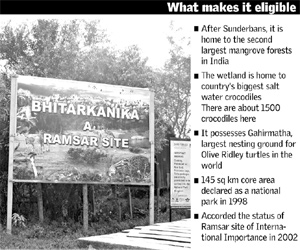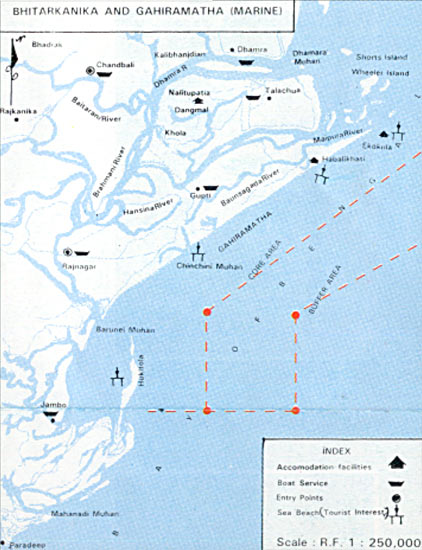Bhitarakanika, a Ramsar site of International importance, is proposed for a world heritage site
Bhadrakh, Bhitarakanika, Dhamara- Chandbali- Bhitarakanika, Ecotourism, Heritage sites, Island tourism, Kendrapada, River Cruise, Tourist promotion, Turtle nesting sites, Wild life February 1st. 2009, 3:09pmFollowing is an excerpt from a report in Expressbuzz.com.
… In India, just five natural sites have been accorded the WHS status. Manas, Kaziranga, Keoladeo, Sundarbans and Valley of Flowers – all national parks – have made it to the list between 1985 and 1988. No natural site has made into the list after that.
Currently, the Sun Temple at Konark is the only site in Orissa to have been accorded the elite WHS status. The Sri Jagannath Temple at Puri was proposed but in vain.
This time around, the Government of India has chosen seven natural sites to be projected before Unesco. Deserts have made it to the list this year.
It is Bhitarkanika’s unique eco-system that has worked in its favour. After Sunderbans, it is home to the second largest mangrove forest in India.
The wetland, one of India’s finest coastal ecosystems, is home to the country’s biggest salt water crocodiles. The latest crocodile census has put their number at over 1,500. Besides, it possesses Gahirmatha, largest nesting ground for Olive Ridley turtles in the world.
However, much depends on the Wildlife Institute of India, Dehra Dun, which is entrusted with the responsibility of presenting the case of the natural sites before Unesco. In fact, role of IUCN too would come to play during selection in case of natural sites.
In view of its exquisite flora and fauna, the State Government had notified it as a wildlife sanctuary in 1975. The sanctuary spreads over 672 sq km. In 1998, the core area of Bhitarkanika consisting of 145 sq. km was declared a national park.
The area was accorded the status of Ramsar site of International Importance in 2002 in view of its unique and fragile biodiversity. A proposal to notify it as a biosphere is underway.
The following map is from http://www.orissatourism.gov.in/IMAGES/map/bbhitar.jpg.
Following are some pictures from a report in Tathya.in.
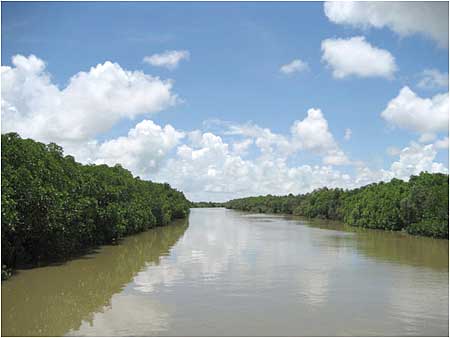
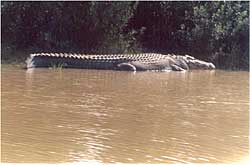
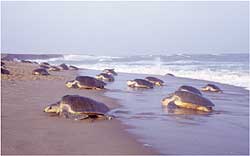
Following is a description of it from http://www.orissatourism.gov.in/bhitarka.html.
Widely acclaimed for its biodiversity in flora and fauna, it is the second largest compact mangrove ecosystem in India. It is also a Sanctuary and National Park. Extending over more than six hundred square kilometres, it is one of the very few evergreen repository of most luxuriant mangrove vegetation in the world. More than sixty varieties of mangrove plants are found here which provide home to a variety of rare and endangered species. The pneumatophores, better known as breathing roots, stand like sentries of the land.
Bounded by rivers on the three sides and the sea on the fourth, Bhitarkanika is criss crossed by numerous creeks and canals which finally meet the sea and make the estuarine delta, the playground of the Bay of Bengal. When the tide enters, the forest floats and the water kisses the foliage. As it recedes, the multi layer mud flats on the banks of the creeks expose their bosom with fiddler crabs, mud skipper fish, little reptiles and the like. it’s a sight to watch.
This deltaic region comprises a couple of tiny islands formed by the meandering creeks. With Dangmal at the centre stage (the others being Ekakula, Habalikhati etc), Bhitarakanika is a natural habitat of a lot of wild creatures like Crocodiles, King Cobra, Pythons, Wild Pigs, Rhesus Monkey, Sambars, Spotted Deer etc. There. is a Crocodile Breeding Farm at Dangmal. The pride possession of this Farm is the White Crocodile Sankhua, a rare species in the World.
Over 170 species of resident and migratory birds of different hue enhance the beauty of the wild. Prominent among them are King Fisher, Open billed Storks, Sea Eagles, Kites, Sand Pipers, Darters, Whistling Teals, Sea Gulls, etc. The chirping of birds nesting at Baga Gahana is sure to leave an indelible impression in any body’s mind. Watching the wildlife in their natural habitat while cruising through the creeks is a thrilling experience. A trek on the laid out routes will also be equally rewarding.
Another amazing phenomenon of nature here is the visit of Olive Ridley Sea Turtles to Gahirmatha in lakhs twice every year between January and March to lay eggs en masse.
An unexpected additional attraction is the remains of tw 9th century monument – a temple dedicated to the worship of Lord Shiva and the other, a Shakti Shrine at Dangmal.
Away from the blinding lights and deafening sound, Bhitarakanika is a different world altogether, a real retreat in the lap of nature. Once in here, the world outside will virtually disappear. Back in work place, the memory will haunt like a fairy tale.
Entry Points :
Permission to visit Bhitarakanika can be obtained from Divisional Forest Officer, Rajnagar, PIN : 754225, Ph: (06729) 72460 or Assistant Conservator of Forests, Chandbali, Pin . 756133, Ph: (06786) 20372 on payment of prescribed fees.
Best season to visit – October to June.Approach : Bhitarakanika can be approached only through water ways. Most convenient entry points being –
* Chandbali (60 km from Bhadrak and 190 km from Bhubaneswar)
* Rajnagar (30 km from Kendrapara and 130 km from Bhubaneswar)
* Gupti (25 km from Rajnagar)Motor boats are available on hire
Rajnagar to Dangmal – 3 hrs
Chandbali to Dangmal – 3 hrs
Gupti to Dangmal – 1.5 hrs
Regular bus service are available to Chandbali and Rajnagar.Nearest Rail head –
* Bhadrak (60 km from Chandbali)
* Balasore (110 km from Chandbali)
* Cuttack (110 km from Rajnagar)
* Bhubaneswar (190 km from Chandbali and 130 km from Rajnagar)Nearest Airport – Bhubaneswar and Kolkata
ACCOMMODATION :
* Aranyanivas, Chandbali
Reservation : Tourist Officer, Balasore. Ph : (06782) 362048
* Forest Lodge-Dangmal, Ekakula, Gupti and Habalikhati.
Reservation : Divisional, Forest Officer, Mangrove,,Forest,Division, Rajnagar. Dist: Kendrapada, PIN -754225 Ph.(06729), 72460.
